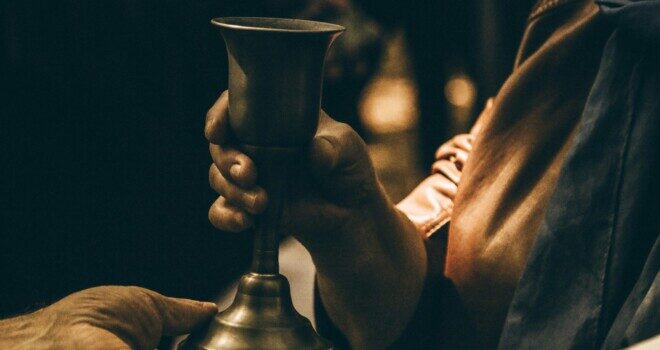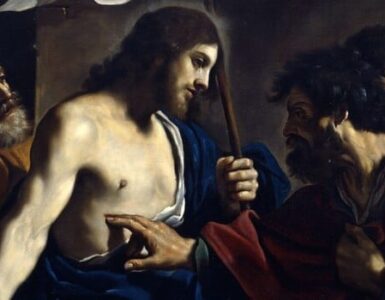Jesus utilized the Passover Seder to not only institute a new ritual that we now refer to as the Mass, but also to bring to fruition His New and Eternal Covenant.
To understand how Christ accomplished this, one needs to understand the ritual that God instituted as a perpetual ordinance upon His chosen people in the Mosaic Covenant. The Israelites were to observe this ritual, the Passover Seder, on each anniversary of the first Passover. This was to be done in remembrance of “the Passover sacrifice of the Lord, who passed over the houses of the Israelites in Egypt; when he struck down the first born of the Egyptians, he spared our houses” (Ex 12:27).
Over a millennium before the coming of the Messiah, the Passover Seder was instituted. This ritual had a unique and defined structure to it, much like we experience in the Mass today. The word Seder itself means “order.”
Our knowledge of this ancient ritual comes down to us from the Mishnah, a collection of rabbinic writings which served as a biblical commentary to the books of the Old Testament. The Mishnah was so revered by the Jews at the time of Jesus, that it was second in authority to the Sacred Scriptures.
This ritual had four parts to it and each part had in common prayers, hymns, blessings, and a cup of wine mixed with a little water which was to be consumed by every participant at the conclusion of each part.
Each of the four cups had a name. The first cup was called the Cup of Sanctification; the second the Cup of Proclamation; the third the Cup of Blessing; and the fourth the Cup of Praise.
During the Last Supper, which of course was a Passover Seder, everything went as was customary during its first two parts. But things changed dramatically during the third part, the Cup of Blessing.
We know that Jesus instituted the Eucharist during the third part of the Passover Seder because St. Paul makes specific reference to it in his first letter to the Corinthians: “The cup of blessing that we bless, is it not a participation in the blood of Christ? The bread that we break, is it not a participation in the body of Christ?” (1 Cor 10:16) [emphasis added].
Did you catch that? A direct reference to the third cup, the Cup of Blessing of the Passover Seder! This is no mere coincidence; Paul was a disciple of Rabbi Gamaliel before his conversion. Rabbi Gamaliel was one of the most authoritative rabbis in all ancient Israel and wrote extensively on the Passover Seder. He is also referenced in the Acts of the Apostles.
By virtue of the institution of the Eucharist, Jesus had changed the order of the third part of the Seder in a significant way. One can imagine how his disciples must have reacted to what had taken place. For their entire lives they had never experienced such a deviation in any prior Passover Seder!
But their shock would have only intensified when “after singing a hymn they went out to the Mount of Olives” (Mt 26:30). The hymn that Jesus and his apostles sung would have been the Great Hallel, Psalm 118, called the Hymn of Thanksgiving. It was always sung at the commencement of the fourth cup, the Cup of Praise. But as the quote from Matthew’s Gospel suggests, the fourth cup was not consumed before they departed for the Mount of Olives. Thus, the Passover Seder remained incomplete!
So, what happened when they arrived at the Garden of Gethsemane on the Mount of Olives? Jesus went off, fell prostrate, and prayed alone to His heavenly Father in these words: “My Father, if it is not possible that this cup pass without me drinking it, your will be done!” (Mt 26:42) [emphasis added].
There it is—an explicit reference to an unconsumed cup. Jesus made this same plea three times in the garden, and each time He made an explicit reference to a cup.
The question that arises: did Jesus actually drink from the fourth cup, the Cup of Praise? And if so, when and how was it done?
He did, in fact, consume the Cup of Praise, and He did so from the cross. St. John’s Gospel reveals:
Here, moments before His holy death, Our Lord shares in the “common wine” and thereby completes the fourth cup. Jesus fulfills the Old Law by carefully completing the Mosaic Covenant’s Passover Seder, instituting the New and Eternal Covenant at the very same time!
Observe further detail of this fulfillment from this passage from the Book of Exodus:
The fact that a hyssop branch is used in the culminating act in both covenants is unmistakable! It almost seems as though they aren’t separate covenants at all, but rather two parts to one continuous covenant. A pre- and post-Messianic Covenant.
As we continue to celebrate the Lamb of God’s redeeming victory over sin and death this Easter season, let us bear in mind the intricate nature of God’s plan for our salvation. Jesus’ last Passover Seder served to bring to fruition the New and Eternal Covenant and produce the essential elements of the Mass, a commemoration of this covenant. See how God’s intelligent design resonates within His glorious plan for our salvation. Alleluia!
Author’s Note: This article was inspired by the book Jesus and the Jewish Roots of the Eucharist by Dr. Brant Pitre. Dr. Pitre’s book changed my understanding of the Faith in a profound way, and I wish to express my deep gratitude to him for his knowledge and insights into this topic.
Photo by Jametlene Reskp on Unsplash











